Small boat with big booty
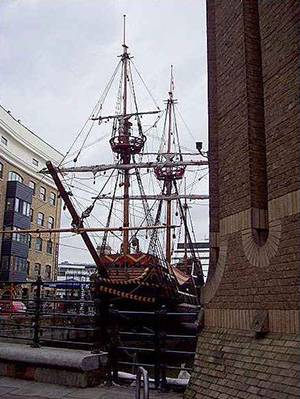
Renewal reigned on the banks of the Thames in the Detfort area as early as the morning of April 4 of 1581. The growing crowd of onlookers awaited the arrival of Queen Elizabeth herself with ever-increasing impatience and curiosity. The event promised to be remarkable, Her Majesty was going to visit a ship that was freshly painted and elegantly decorated with flags, which came here on a special occasion. More than two years of trekking and fighting in three oceans, distant continents, islands and archipelagoes were left astern of this sea pilgrim, bearing the resounding name "Golden Doe".
For the convenience of climbing the ship of the high guest and her numerous suite, a wooden bridge was equipped, on which the idle people now crowded. At some point, confusion and crush arose, the bridge collapsed, and part of the loyal subjects of the virgin queen found herself in the cold waters of the Thames. However, the design was quickly restored, and by the arrival of the royal convoy, they were quick to forget about the annoying embarrassment. Under drumming and drawn-out sounds of pipes, Elizabeth climbed aboard the Golden Fallow Deer. The queen was 48-th year, but she still did not leave the thought of marriage. She was tirelessly accompanied by the personal representative of the duke of Alençon, King Henry III's brother of Valois, de Marshomon. The latter was supposed to begin negotiations on the marriage of the duke and queen as soon as possible.
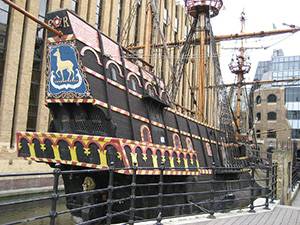
Elizabeth was distinguished by the intelligence and sharpness of the language, and when visiting the Golden Fallow deer, she could not deny herself the pleasure of once again snarling at the Spanish for the time being partners. Francis Drake, a man with a tanned and scarred face, who recently brought this ship to Portsmouth Harbor, knelt for a ceremony. Holding the sword in her hand, the queen noticed that the king of Spain was demanding the return of the precious booty of the Golden Fallow deer along with the head of her captain Francis Drake, and that she had in her hand a gilded sword with which she would “execute him”. On the deck of the ship, the bold and talented pirate was knighted, and assisted by the queen at her request, none other than de Marshomon - it was a political and pronounced anti-Spanish attack, symbolizing the Anglo-French cooperation.
[Center]
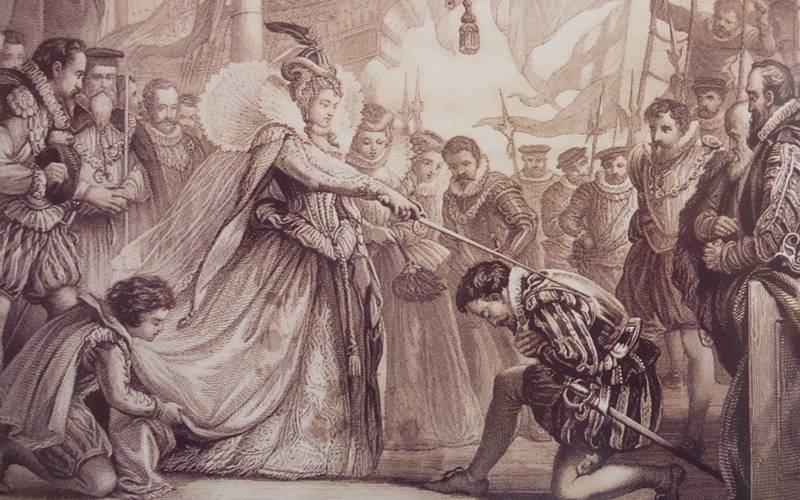 [/ Center]
[/ Center]After the ceremonial part, there was a grand banquet, where the captain - already Sir Francis Drake - was pouring courtesies and gifts. Elizabeth was presented with a large silver chest and a frog adorned with jewels, as if hinting at the person of a possible fiancé, the Duke of Alençon - Her Majesty with her characteristic sarcasm called that “my frog”. The officers and courtiers received impressive cash presents that day. The life course of Francis Drake was once again accompanied by a strong tail wind. Ahead was a successful career, wealth, success and, of course, fame. The navigator received all these advantages, having made the second world trip after Fernand Magellan and brought in the holds of the “Golden Fallow deer” booty on 600 thousand pounds, which was equal to two annual budgets of the English kingdom. And for this you could welcome knighthood, closing his eyes to many things. Even on the turbulent scenes of the Spanish Ambassador Bernardino de Mendoza.
Golden rivers, silver shores
The discovery of the New World gave an unprecedented impulse to the development of Spain. The royal power acquired territories, the size of which was impressive even on maps, energy, pressure and ambitions of the impoverished nobility who had become bored after the Reconquista ended, were sent in the right direction. And most importantly, from across the ocean, the coveted gold began to flow in an ever more tangible flow. One after another, Indian states were crumbling, giving winners mountains of loot and trophies. Gold became more and more - it was cleverly smelted into ingots, carefully laid in the holds of the galleons, after which they started on a long and difficult journey to Europe. The magnitude of the acquired wealth struck: how majestically these treasures looked compared to what could be removed from the Moorish cities and castles, at a time when the state treasury often fit in several iron-bound chests.
Gold streams flowing from different places of Central and South America gradually merged into a full-flowing stream of precious metal that was striving across the Atlantic. He gave Spain wealth and power, power and strength. And he will become the source of her weakness, which has passed into weakness, but this will happen much later. So far, the court was the XVI century, and the proud banner of the Spanish monarchy was held in his pious and ruthless hands of Philip II. His possessions were truly immense, and His Majesty’s army and fleet inspired fear and respect for all its many enemies.
However, there were those who looked at the power of Spain with a little less fear and even less reverence, as they were attracted by more mundane and practical feelings. England, for a number of reasons, did not manage to plunge the fangs into the most tidbits of the American pie, it fit to scoop a generous handful, and if it succeeds, with something more voluminous from the current of gold flowing across the Atlantic. Queen Elizabeth, who had a childhood that was not overloaded with tenderness and sentiment, survived the mother's execution too early, was disgraced by the powerful and cruel father, Henry VIII, the death of her brother and sister, was an extraordinary ruler. Possessing excellent teachers, well-read and inquisitive, she also received a second education, the value of which was even higher than the educational truths - life.
England was in dire need of funds for the development of its own economy, trade and manufactory production. Resources were needed to confront powerful and, moreover, Catholic Spain. And they simply did not have the opportunity to extract quickly and in sufficient quantities, except for how to borrow from the same Spain - by well-organized weaning. For this purpose, Elizabeth, the “queen of the devil,” as some called her very seriously, needed two things: ships and captains. In England, the XVI century is known, among other things, also by a whole galaxy of sea pirates, many of whom were awarded the knighthood. And no wonder - in medieval (and not only) Europe, the line between a robber and a knight was oddly thin.
Tough guy from devonshire
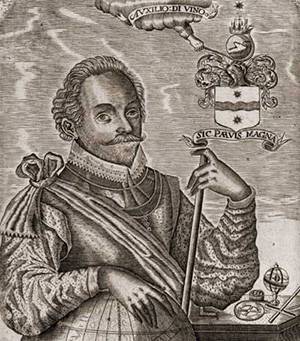
The life journey of Francis Drake to the knightly title and rank of admiral began roughly between the 1540 and 1545 years in Devonshire. The boy was born in the family of a yeomen, and already in 12 years he sailed as a simple cabin boy of a merchant ship and has not parted with the sea since then. He showed himself well in the maritime business, and therefore, when the owner of the vessel, who was related to Drake as a relative, died, he bequeathed his ship to Drake. So almost in 18 years, Francis became the full owner of a small barge "Judith".
A few years later, in 1567, at the suggestion of another relative, John Hawkins, he made an expedition with other British ships to the West Indies. The Caribbean has already become a breeding ground for the formation of a whole pirate industry, seizing the Spanish galleons with gold and silver. Another profitable business flourished here - the slave trade from Africa. That is exactly what Hawkins planned to do. Having seized slaves in Guinea, and a part of the prisoners was presented to him by the local leader as a sign of gratitude for the services rendered in the fight against opponents, the British went to the West Indies, where they planned to sell the "live goods" profitably. Initially, their commercial activity was quite profitable - part of the Africans were able to profitably sell in the colonies of the West Indies. But then the expedition was attacked by the Spanish squadron, from which only Judith and the Mignon Hawkins ship could escape. They returned to England separately from each other, and a cruel famine raged on the Mignon, which destroyed most of the crew. However, much of the spoils obtained from the deals and captured from the Spaniards were saved, and it brought a good profit.
Having quickly understood the prospects, and first of all financial, Drake in 1572 organized his own expedition to the West Indies in order to disturb the peace and financial well-being of the Spanish king’s local citizens. On two ships called Pasha and Swan, together with his younger brother, the corsair headed for the Panama area, where one of the most important transportation and transshipment hubs for sending silver and other jewels to Europe was located. During this campaign, he was fortunate enough to capture a large amount of silver in the area and return in August 1573 to Plymouth as a rich and famous person.
Of the many English corsairs who hunted in Spanish communications, Drake showed himself to be one of the most extraordinary, courageous and lucky captains. With the proceeds, the corsair purchased a large house and three ships, becoming the shipowner himself. For several years his life was more or less calm. However, in 1575, the next round of aggravation of the Anglo-Spanish contradictions begins, when the arguments are already beginning to be measured with the mass of a cannonball. At the court of Queen Elizabeth, too, were not opposed to clean the gun vents. Secretary of State Francis Wallingsham, who is also the head of the “war party”, proposed a bold plan: to equip and send a naval expedition, whose task would be to strike Spain in the most sensitive and vulnerable parts of the world.
For the position of commander of such an enterprise, Wallingsham was proposed by Drake, with whom he was personally acquainted. The idea came to mind - a special commercial community was created on equal footing, into which the Secretary of State himself, high-ranking courtiers and merchants invested. Drake also contributed a significant amount. All these measures were taken to finance a risky, but promising expedition to good profits. The most appropriate area of action, according to Drake, was to be America. The corsair was awarded a secret audience with Elizabeth, who fully supported the idea and plan of the enterprise, wishing to take personal, but secret financial participation in it. The Queen strongly recommended Drake to keep her mouth shut, otherwise threatening to cut off his head.
The entire first half of 1577 was in preparation for the expedition. All information about the upcoming plans kept secret. Firstly, the Spanish ambassador Bernandino de Mendoza had enough gold to maintain the enthusiasm of his numerous informers, and secondly, in London there was also an influential peace party that did not want war with Philip II and therefore could do nonsense. The crews of the ships, as it were, by the way spoke of going to the Mediterranean Sea. De Mendoza, on the other hand, was confident that Drake would go to Scotland. Relations between England and Spain reached the mark of "hopeless", and in the upcoming war, no one doubted. In London, openly recruited volunteers for upcoming ground operations in the Netherlands. Amid increasing rhetoric of rhetoric, Drake went out to sea almost unnoticed. 15 November 1577, his ships left Plymouth.
Across the ocean
The coast of England under the command of the corsair left (as it turned out soon, not for long) five ships. The largest of them was the Pelican - with a carrying capacity of just over 100 tons and equipped with 22 guns. The role of the junior flagship was performed by the 80-tonne "Elizabeth" under the command of John Winter, a representative of a noble family who took part in the financing of the expedition. The other three ships were smaller: the 50-tonne Benedict, the 30-tonne Goldstone and the 15-tonne Swan. The personnel on all ships counted 164 people who were told before sailing that the squadron was sent to Alexandria. However, shortly after the ships sailed, they were caught in a storm, and some of them were seriously damaged. I had to return to Plymouth and, after making the necessary repairs, go to the sea on November 28, finally leaving my native harbor.
[Center]
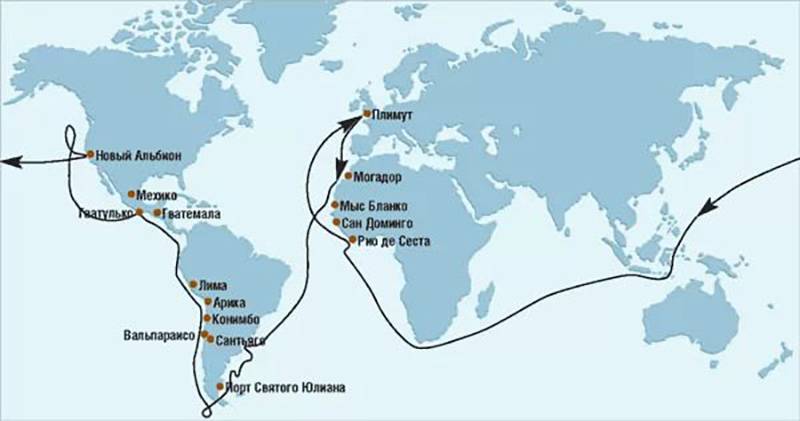 [/ Center]
[/ Center][center] The scheme of the round-the-world expedition "Golden doe" [/ center]
In case of loss of each other from the view of the sea, a gathering point was agreed at the island of Mogador, located off the Moroccan coast. December 25, taking advantage of fair winds, Drake's squadron gathered at the designated location. After replenishing stocks and concluding a number of commercial transactions with the local population, the ships moved towards Cape Cap Blanc on the west coast of Africa. In the middle of January, the new year, 1578, came to this point, capturing several Spanish ships along the way. Taking away all the valuables and most of the provisions, Drake released the Spaniards. He decided to keep one of the captured ships in his possession, giving the owner Benedict instead. The new member of the expedition was renamed “Christopher”.
A few days later, the British took off their anchors and headed towards the Cape Verde Islands, where a Spanish ship was captured with a large load of various goods. However, the most valuable trophy was the presence of the most experienced navigator on the Spaniard, Xnum-year-old Nunesh Silva, who, after the Spanish crew was released, Drake kindly asked to stay. Subsequently, Silva was on the squadron as a navigator for more than 60 months.
In early February, the ships left the Cape Verde Islands and moved towards Brazil. Now all the crews knew about the goals and objectives of the campaign. 1 April 1578 g. Forward-looking people finally noticed the shore. It was South America. Overcoming the Atlantic passed unhindered, and on April 5 the squadron approached the coast of the mouth of La Plata. Crews needed rest after a long voyage. After waiting out a sudden storm, largely due to the skill of Nunesh Silva, and taking the necessary respite, Drake entered the mouth of La Plata and moved up the river. The hike was calm, it was possible to replenish supplies of fresh water.
A week later, Drake turned back and, leaving the river, headed south along the coast. It turned out that one of the ships, the Swan, was gone. Signals that his commander, Thomas Doughty did not have a sufficient degree of reliability, Drake received back in England, but at first did not attach any importance to this. On May 12, the ships anchored in a convenient bay, but suddenly darkened, and a storm began. The next morning, it turned out that the "Goldflower" had disappeared. Moving further south and reaching St. Julian's Bay, memorable because Magellan himself stayed in it, Drake decided to organize a search for the disappeared ships with his thinned flotilla.
"Elizabeth" was sent to the south, and the corsair headed north, where he soon met the disappeared "Swan". All the supplies and weapons were removed from the fugitive, the crew was distributed to other ships, and the Swan itself was destroyed. A trial took place over Doughty: he was accused of stealing loot from a Spanish ship that was loaded onto the Swan and in desertion. He was convicted, and a few days later the former captain was beheaded near the place where 5 years ago, Magellan hung up the vice-admiral of his expedition X. Cartagena in similar circumstances.
The August 17 flotilla, which had decreased in size after a two-month stay in Julian's Bay - a long rest before a long hike - continued on its way. Now there were only three ships in it: the Pelican, the Gold Flower and the Elizabeth. The Swan was destroyed as early as May, and the condition of the Spanish trophy ship Christopher was considered not appropriate for a further voyage, and they also got rid of it.
20 August, the British saw the Cape of Virgins, or, as the English called it, the Cape of Virgin Mary. In honor of the English Queen Virgin, a salute was made, and then Drake ordered to rename his flagship "Pelican" to "Golden Doe". This animal was depicted on the coat of arms of the royal favorite Christopher Hetton. 22 August 1578 Drake’s flotilla entered the Strait of Magellan, soon the corsairs were to get acquainted with the new ocean - the Pacific.
The terrible expanses of the Pacific
The crossing of the Strait of Magellan took place slowly, with stops for replenishing water supplies and hunting for seals. The local population, meeting the British, was friendly, willingly agreeing to barter trade. 6 SEPTEMBER Drake and his companions saw the Pacific Ocean. The British called it the South Sea. The very next day, September 7, a violent storm broke out, which, according to eyewitnesses, did not subside, 52 of the day. Soon the ships lost sight of each other, and the “Golden Doe” drifted much further south. A strong wind was blowing, the sun was not visible during the day, and the moon and stars at night. This continued until October 28, when the elements finally calmed down. All the famous maps of the time, south of South America, depicted a huge continent called the Unknown Southern Land. Drake found out on his own experience that to the south of the Strait of Magellan there is not a huge continent, but a vast expanse of water. When they reached Cape Horn, the Golden Fallow Deer made a two-day stop there, where the ship's pastor Fletcher left a memorable inscription.
Even before the flotilla entered the Pacific Ocean, Drake had foreseen a situation in which ships could lose each other, and appointed a collection point in advance. October 30 corsair flagship was already in sight of the coast of Peru. Moving along the coast to the north, Drake 25 November reached the island of Mucho, where it was decided to replenish supplies of fresh water. The commander of the expedition together with a group of sailors landed on the shore. Local Indians first met the newcomers friendly, brought fresh provisions, and promised to show the water sources. The next day, the British landed on the island again, but were heavily fired from bows - some crew members were injured. Drake was offered to bombard the island with cannons, but he refused, suggesting that they were mistaken for Spaniards, whom the local population had serious reasons to dislike. Then Drake and was wounded by an arrow in the face. The chief doctor of the expedition died, his assistant was on the missing "Elizabeth", so Drake had to deal with the treatment of his subordinates himself. All of them, except for two (the sailor who received more than 20 injuries and the servant of the captain) recovered.
30 November “Golden Doe” anchored in 15 miles from the Spanish port of Valparaiso. Replenishing food and water with the help of local residents, Drake decided to pay a courtesy visit to the owners of these places. 5 December 1578 “Golden Fallow Deer” entered the Valparaiso raid. The Spaniards did not even doubt that it was their ship - in their opinion, there could simply be no other way in these waters. Anchored the vessel "Captain Morial", loaded with wine and gold. The Spaniard was glad to guest and met him with drumming. Meanwhile, Drake lowered the boat and, together with the boarding party, armed to the teeth, approached the board of "Captain Morial." Then everything happened quickly and not at all solemnly. The Spanish captain who met the guests was knocked down by a stick, and soon the British seized Captain Morial. None of the team was killed, and she was locked in the hold. The attackers got big booty. After which the British visited Valparaiso himself.
The city consisted at that time of a dozen houses and several warehouses, besides, in a hurry left by a frightened population. Having loaded all the food found on the boats and having sent a group of sailors to the "Captain Moriel" to manage, the Golden Fallow deer and its prisoner left the harbor. The Spanish crew was sent ashore except for the navigator and two more sailors. In addition, Drake collected all available Spanish cards. In a secluded bay, among other things, 170 barrels of the best Spanish wines were unloaded from the trophy vessel.
After a brutal two-month storm, which the Golden Doe made when meeting the Pacific Ocean, the ship began to leak, and it needed repair. After several unsuccessful 22 attempts in December 1578, a suitable bay with a lot of fish was found. Repairs continued until the middle of the next month - a new 1579 year was met right there in the bay. January 18 lonely Drake's flagship headed north. The corsair did not lose hope of finding his disappeared companions - so far there has been no news of either “Elizabeth” or “Gold Flower”. Along the way, the British repeatedly landed on the beach in search of fresh water, in which they experienced constant need. There were also attacks on small Spanish coastal towns, in which, however, it was possible to take rich booty.
Finally, in 15 miles from the port, Callao Drake intercepted a small Spanish ship from Lima. He had no interest as a trophy, but his captain gave the British some interesting information. According to him, there were ships in Callao that came there with a load of gold and other valuables. Some of the contents of the holds were already unloaded, but there was a chance that some were not yet spared their precious burden. At night, Drake entered the harbor of Callao, where several dozen ships were anchored. The “golden doe”, not suspected of anything, stood between them. The boarding party inspected a number of ships whose crews were on the shore - the Spaniards were so confident in their safety that they were scornful of guards and watches. However, the holds of abandoned ships were really empty.
Nevertheless, from several sailors taken by surprise, the corsairs managed to figure out some news, as well as information about the Spanish shipping in these waters. While the corsairs cut the anchor ropes in order to create additional confusion in case of pursuit, the customs officials who arrived arrived at a suspicion that something was wrong and raised the alarm. The Golden Fallow Deer had to be urgently removed from the anchor, capturing the next Spanish ship Saint Christopher on the way out of the harbor with rich booty. When the Spaniards came to their senses, they sent two hastily equipped ships after Drake. Seeing the chase, the corsairs overloaded all the booty from the “St. Christopher” to themselves and released him along with the released prisoners. The pursuit of the Golden Doe lasted a whole day and was not expected to be a success. The pursuers returned to Callao with nothing, and the successful corsairs continued their march northward.
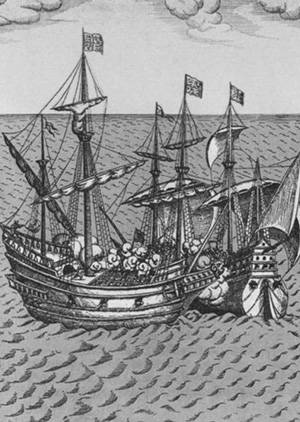
[Left]
The enraged viceroy of Peru, don Luis de Toledo, was furious and ordered to send a high-speed frigate all along the coast to warn that the Devil Drake was operating in the local waters. The troublemaker himself, who did not at all claim to such a loud title, continued his voyage, occasionally disembarking on the shore, where he collected information and replenished supplies. Thus, information was obtained about Cacafuego, a large merchant vessel carrying gold and valuables, which was a couple of days ahead of the Golden Fallow deer. Drake immediately organized a chase.
1 March, the British overtook the coveted prize and seized it without resistance. On board, there were gold and other jewels on 400 thousand pesos, of which over one hundred thousand belonged to King Philip II. It was a very solid sum, considering that the sum of all the previously captured production amounted to about 440 thousand pesos. After the precious cargo of Kakafuego moved to the hold of the Golden Doe, the Spaniard was released on March 7. After some time, the captain of the "Cacafuego" gave detailed testimony to the Panamanian colonial authorities regarding the English ship, impressions of conversations with Drake himself and assumptions about his future plans.
The corsair still hoped to meet his companions, but this hope was becoming weaker from month to month. In April, 1579 “Golden Doe” was already in the Central American waters, causing many troubles to the local governors. 13 April Drake called at Guatulco, a small but important transport port, causing a stir from the locals. Having replenished the provisions and leaving all the Spaniards and the Portuguese de Silva on the shore, the Golden Fallow Deer again went into the ocean.
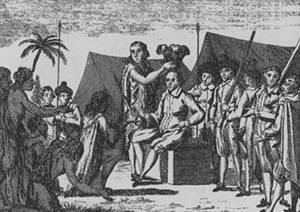
[left] [/ left] Drake and the Indians of New Albion. From the book of D. Henry. 1774
The corsair was planning to return home not yet walked by - among sailors and geographers there were rumors about the existence of a passage between the Pacific Ocean and the Atlantic, only in the north. Thus, the idea of the Northwest Passage was born in an obscure haze. The Englishman thought it was worth walking relatively close to the north and it would be possible to return to the Atlantic again through the strait. The shores were deserted and monotonous, the temperature steadily declined. The fogs began, and after them the snowfall. The mood of the team fell, and, realizing that the northern passage to the Atlantic was impossible in these realities, Drake turned south.
17 June 1579 north of present-day San Francisco, the British landed and proceeded to build a fort to defend against a possible attack by the Indians. The Golden Doe was in need of repair before the expected roll across the Pacific. But relations with the Indians were so friendly that Drake decided to declare these lands the possession of Queen Elizabeth called New Albion. But between the new lands and the native Plymouth 16 remained thousands of miles, and it was necessary to return. The British planned to go home through the Moluccas and the Cape of Good Hope. 23 July 1579 “Golden Fallow Deer” left the stern American coast, starting the way home.
Return
The first land after crossing the ocean, the British saw the September 30 - after the 68 days of swimming. The natives, having received various gifts from the board of the Golden Fallow-deer, did not give anything in return - Drake called this land the island of Thieves. At the end of October, the Golden Fallow Deer passed by the Philippines and on November 3 approached the shores of the Moluccas. The local sultan, who liked English music very much, welcomed the guests, providing them with fresh provisions. On November 9, on a small island south of Celebes, a four-week stop was made to prepare for the finish line.
12 December, the land that received the name of the island of Crabs for abundance on it of characteristic living creatures, remained astern, and on January 9 on 1580, the ship suddenly hit a rock and was firmly stuck. The situation seemed critical - the sea was worried, the only boat could accommodate only 20 from 58 team man, and the wind was offshore. Drake, who had not lost his presence of mind, ordered to throw all unnecessary things overboard, including some supplies and weapons. Inviolability remained only for jewels. After 20 hours of continuous effort, the Golden Fallow Deer was freed from captivity, and she went on.
Now the good weather favored Drake - on June 15 his ship reached the Cape of Good Hope, August 22 was left behind as the Canary Islands. 26 September 1580, two years later, nine months and 11 days, the Golden Fallow Deer entered Plymouth. The first of the compatriots who was met by the ship returning from the circumnavigation was a fisherman on a boat - they asked him if the queen was alive and received an affirmative answer. It was not crowded on the shore - on Sunday most of the people were in the church, so the meeting of corsairs who brought booty worth more than 600 thousand pounds sterling was more than modest. Moreover, at the queen's court, disputes about the legality of Drake's seizure of such enormous wealth began. Doubt allowed Elizabeth herself, ordering her pirate to come to her palace.
The fate of the two other ships Drake was not so lucky: "Gold Flower", apparently, was killed during a storm, and "Elizabeth" returned home to England on the initiative of its captain. Honored honors, wealth and fame fell upon Drake. 4 April 1581 was knighted on the deck of the Golden Fallow Deer. But the main thing was still waiting for Sir Drake to come - the war with Spain was becoming inevitable, and soon the famous Invincible Armada will go to the shores of Albion. But this is another story.
Information